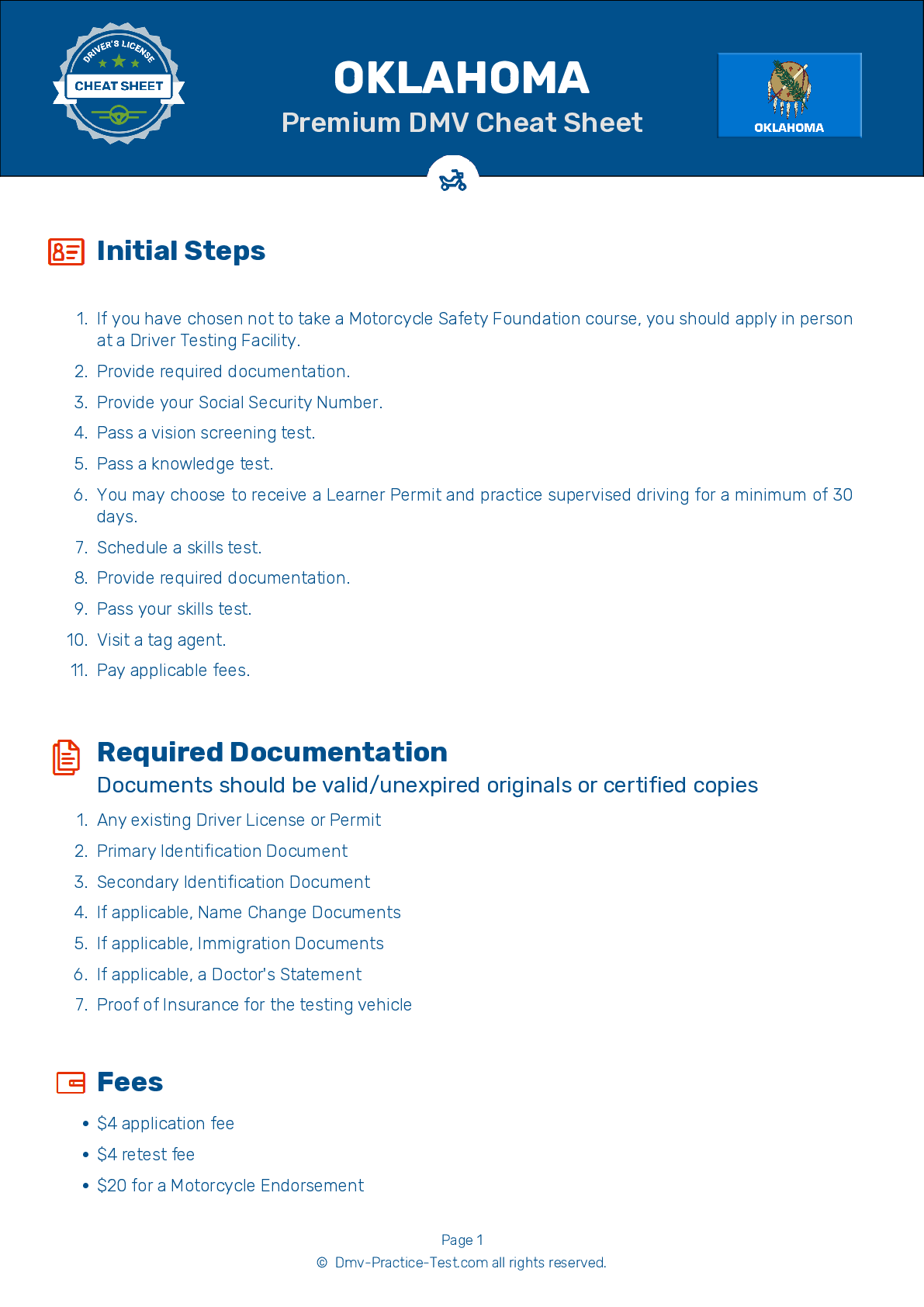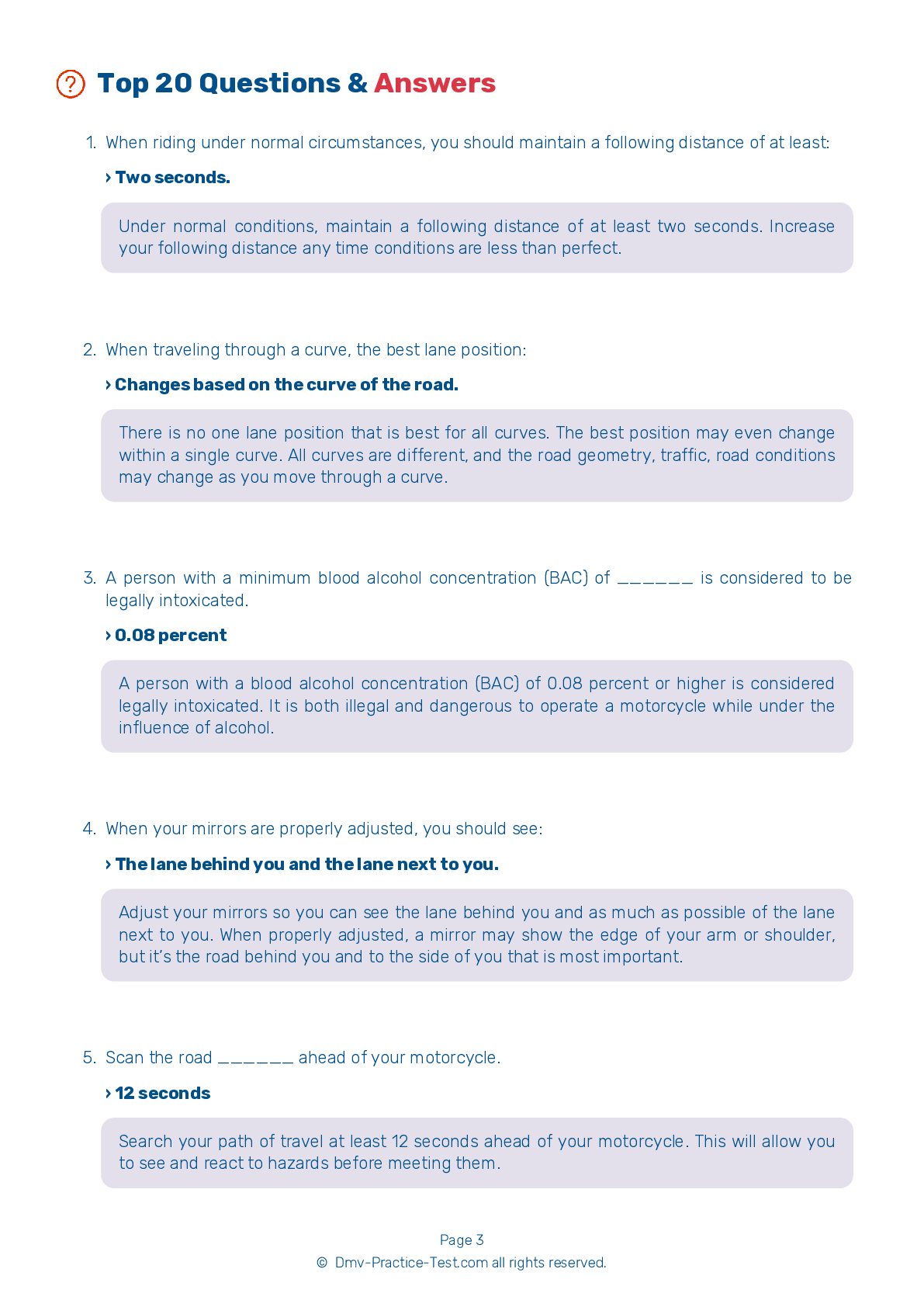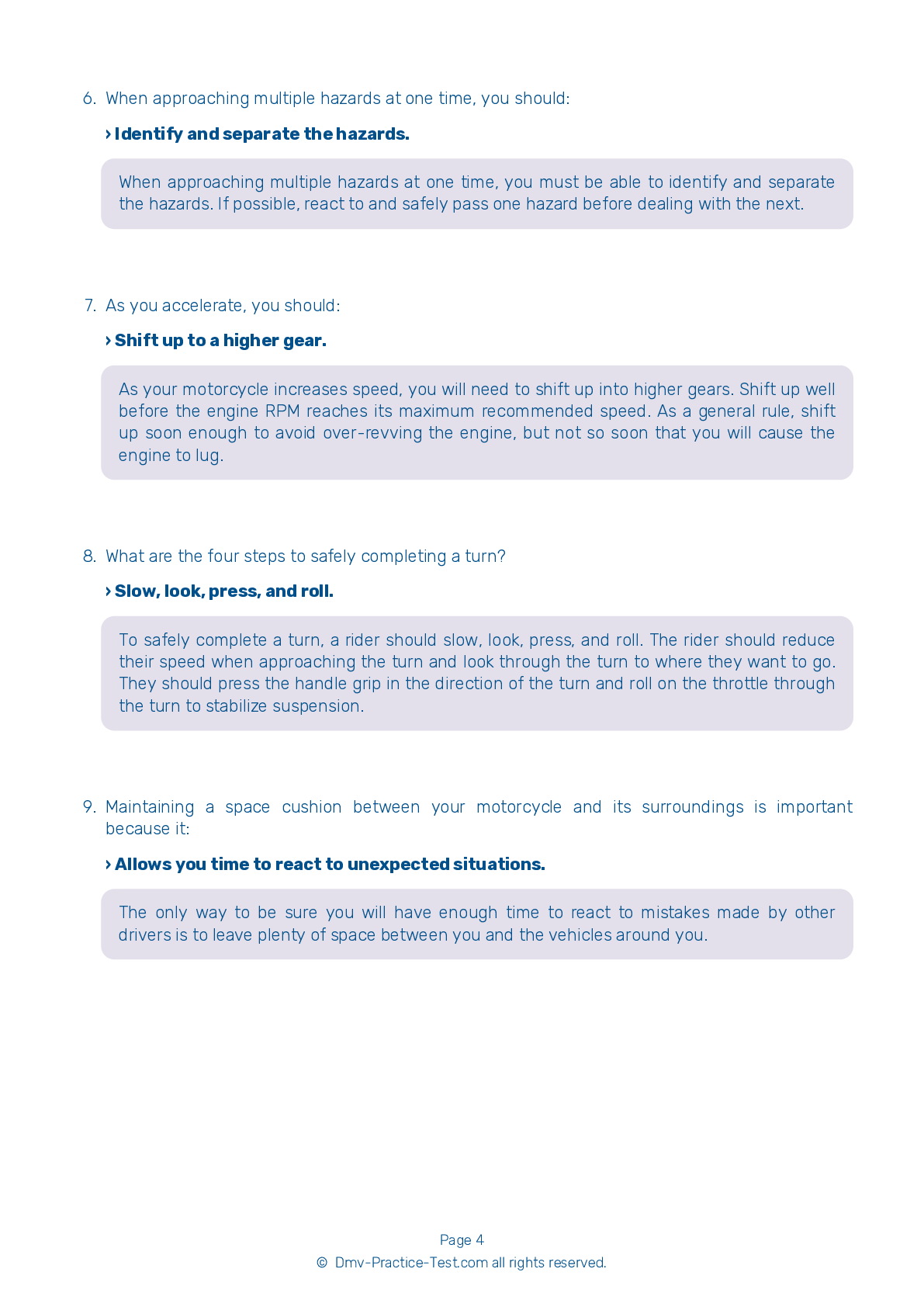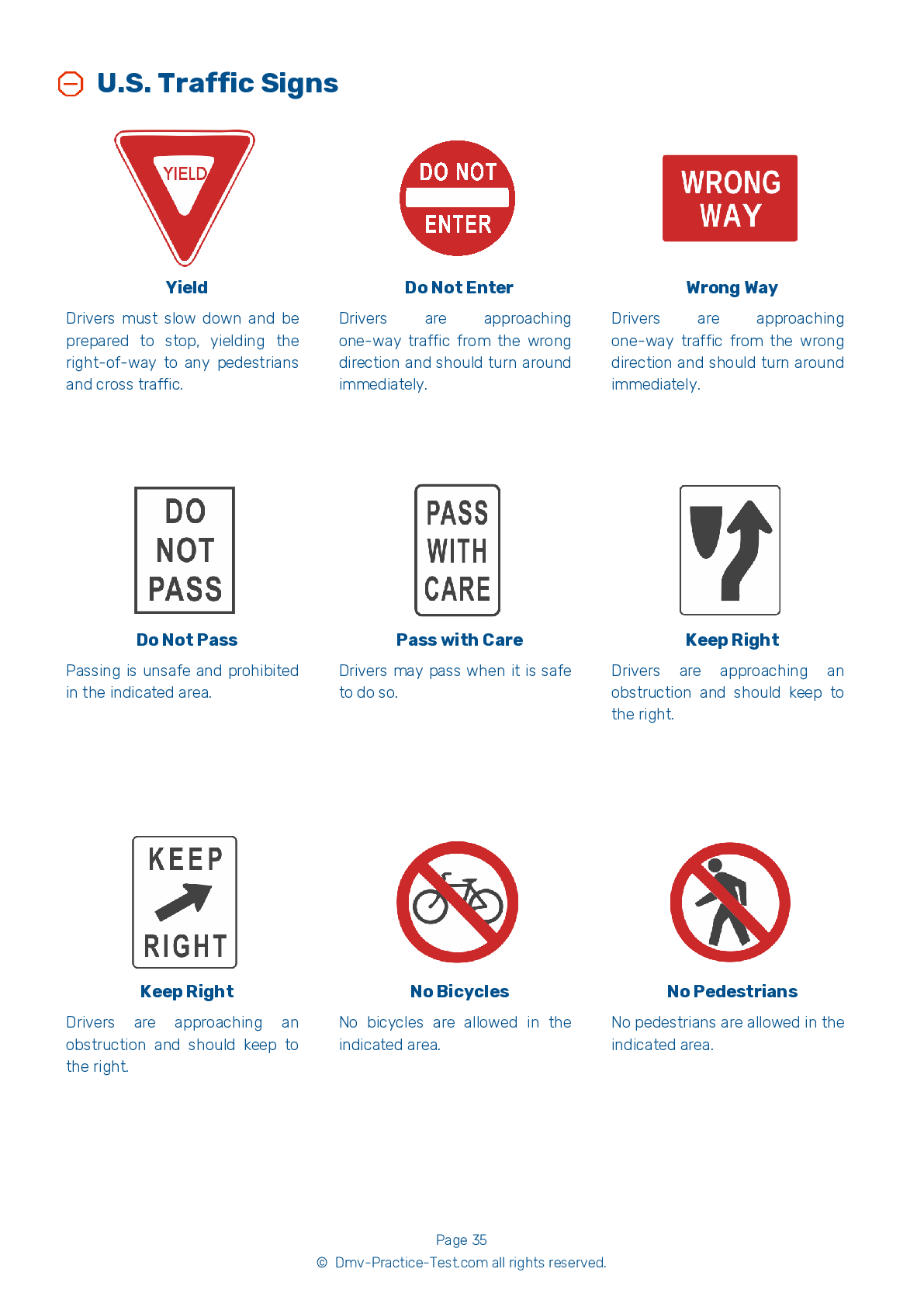DMV Permit Test #12
Motorcycle Test | License OK 2025 | FREE Online Practice! #12
Take this FREE motorcycle test (license in OK 2025) to check your knowledge of the road rules. To improve your results, download a motorcycle handbook online, study theory, and practice for free on our website. Still worried about how to get a motorcycle license in Oklahoma in 2025? Check our website for more sample tests, train as much as possible, and boost your grades!
20
15
16
1 . This road sign means:

Come to a complete stop before proceeding.
If you drive past these signs, you are going the wrong way and are at risk of a head-on collision. You should cautiously turn around.
2 . When riding at night, a motorcyclist should:
All of the above.
Riding at night can be dangerous because a rider’s ability to see and be seen by fellow motor vehicle operators is limited. It is recommended that riders adjust their riding behavior to compensate for this limited visibility by reducing their speed, maximizing their headlight usage, and increasing their following distance.
3 . A motorcycle passenger should:
Force the operator to sit closer to the front of the bike than they normally would.
Motorcycle passengers should wear the same protective gear that is recommended to operators. Without crowding the operator, a passenger should sit as far forward as they can and hold firmly onto the operator's waist, hips, or belt. They may choose to hold onto the bike’s passenger handholds, if available.
4 . Your knees should be:
Wherever you prefer.
Keep your knees against the gas tank to help with your balance as you turn the motorcycle.
5 . In addition to hazardous road conditions, riders should search for:
All of the above.
Riders should continually scan ahead of, to the sides of, and behind their motorcycles. They should look for hazardous road conditions as well as traffic that could become hazardous.
6 . Which of the following surfaces is unlikely to provide poor traction for motorcyclists?
An ice patch
A number of surfaces can provide poor traction for tires. Wet pavement; roads covered in loose gravel or sand; muddy, snowy, or icy areas; painted lane markings; and metal covers and plates in the road can be more hazardous for a motorcyclist than dry pavement.
7 . When riding on a slippery surface, you should:
Avoid making sudden moves.
Avoid making sudden moves when riding on a slippery surface. Any sudden change in speed or direction can cause a skid. Operate as smoothly as possible when speeding up, shifting gears, turning, or braking.
Need Motorcycle Insurance? No problem!
Compare the best rates in Oklahoma and find a personalized policy that meets your needs.
1. Are You Currently insured ?
2. Married ?
3. Do you own your Home?
4. Have you or a Family Member Honorably Served in U.S. Military ?
5. Your Name
6. Age
7. Zip code
Ranked by best match
2025 Oklahoma | Frequently Asked Questions
To acquire a motorcycle license in Oklahoma, you must first obtain a motorcycle learner's permit by passing a written exam. After practicing with the permit, you can apply for a motorcycle endorsement on your driver's license by passing a skills test. Alternatively, completion of an approved Motorcycle Safety Foundation course can waive the skills test requirement.
In Oklahoma, the minimum age to obtain a motorcycle license is 14. However, applicants under 18 are required to complete an approved Motorcycle Safety Foundation rider course. They must also have a signed consent from a parent or guardian and provide proof of school enrollment or graduation.
Yes, in Oklahoma, you need a dedicated motorcycle license or an endorsement on your regular driver's license to legally operate a motorcycle. To get this, you must pass a written test, a vision screening, and a motorcycle skills test. If you're under 18, you'll also need to complete a Motorcycle Safety Foundation rider course.
To apply for a motorcycle license in Oklahoma, you will need to provide proof of identity (like a birth certificate or passport), proof of Social Security number, and two proofs of Oklahoma residency. If you are under 18, you will also need a parent or guardian's signature on the application and proof of enrollment in school.
Yes, you will need to take a written exam to get a motorcycle license in Oklahoma. This test covers topics like traffic laws, safe riding techniques, and road signs. However, if you complete an approved Motorcycle Safety Foundation course, you can bypass this written test. Make sure to study the Oklahoma Motorcycle Operator's Manual before the exam.
The motorcycle written test in Oklahoma covers a range of topics including road rules, motorcycle laws, and safe riding practices. It also includes questions on identifying road signs, understanding motorcycle controls, handling emergencies, and dealing with hazardous conditions. The test is designed to assess your knowledge and understanding of operating a motorcycle safely.
Yes, in Oklahoma, you can substitute the written test for a motorcycle license with a Motorcycle Safety Foundation (MSF) Basic Rider Course. Upon successful completion of the course, you'll receive an MSF card, which the Oklahoma Department of Public Safety accepts as a waiver for the written test.
Enrolling in a motorcycle training course in Oklahoma involves a few steps. First, research approved courses in your area. Once you've chosen a course, you can usually register online or by phone. You'll need to provide personal information and pay a fee. Some courses require you to have a motorcycle learner's permit before enrolling, so check the specific requirements of the course.
No, you don't have to own a motorcycle to take the license test in Oklahoma. You can use any motorcycle that is insured, registered, and meets all safety requirements. However, it's important that you are familiar with the motorcycle and it fits your size and skill level for the test.
Yes, you can use a friend's motorcycle for the driver's license test in Oklahoma, as long as the vehicle is properly insured, registered, and meets all safety requirements. Remember to bring proof of insurance and registration to the test. The motorcycle should also be appropriate for your height and size.
Yes, the Oklahoma motorcycle driving exam tests specific handling skills. These include proper starting and stopping, turning and swerving, quick stops, and obstacle avoidance. The test also assesses your ability to balance at low speeds, signal appropriately, and maintain a safe distance from other vehicles. You'll need to demonstrate proficiency in these areas to pass the exam.
Yes, in Oklahoma, new motorcycle drivers under the age of 18 are subject to some restrictions. They are required to complete a Motorcycle Safety Foundation rider course and cannot carry passengers for the first six months after getting their license. They must also wear a helmet until they turn 18.
Yes, your Oklahoma motorcycle license is valid across all 50 states due to the Full Faith and Credit Clause of the U.S. Constitution. However, you must abide by the traffic laws of the state you are in, including helmet laws which can differ from Oklahoma's. Always check local regulations when traveling out of state.
In Oklahoma, only motorcycle operators and passengers under the age of 18 are required by law to wear a helmet. However, regardless of age, it's always a good idea to wear a helmet for safety reasons. Always ensure your helmet meets the Department of Transportation's standards.
Yes, in Oklahoma, there are two types of motorcycle licenses: a motorcycle-only license and a motorcycle endorsement on an existing driver's license. The type of license you choose depends on whether you want to drive only motorcycles or both motorcycles and other vehicles.
Yes, you can add supplementary endorsements to your motorcycle license in Oklahoma. These endorsements recognize additional skills like operating a commercial vehicle or school bus. To add an endorsement, you generally need to pass both a written test and a skills test. Check with the Oklahoma Department of Public Safety for specific requirements.
Yes, the Oklahoma Department of Public Safety provides the motorcycle license test in several languages other than English. However, it's advisable to contact your local testing center in advance to ensure that the test is available in your preferred language.
An effective strategy to prepare for the motorcycle license test in Oklahoma is to study the Oklahoma Motorcycle Operator Manual thoroughly. The manual covers all the information you'll need for the test. Additionally, taking online practice tests can be beneficial as they simulate the actual exam and help you identify areas that need further study.
Yes, the Oklahoma Department of Public Safety provides the motorcycle written exam in several languages other than English. However, it is recommended to contact your local testing center ahead of time to ensure that the test is available in your preferred language.
If you fail the motorcycle written test in Oklahoma, you can retake it. However, you must wait at least one day before attempting the test again. This allows you time to study and prepare to pass on your next attempt. There's no limit on how many times you can retake the test.



